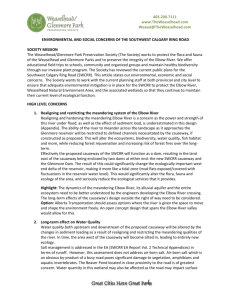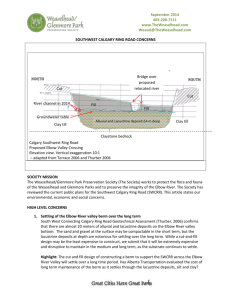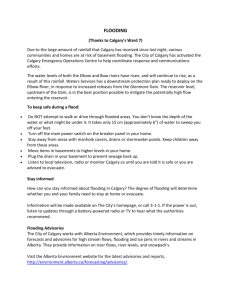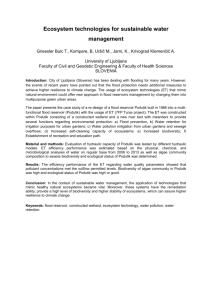ENVIRONMENTAL AND SOCIAL CONCERNS OF THE
advertisement
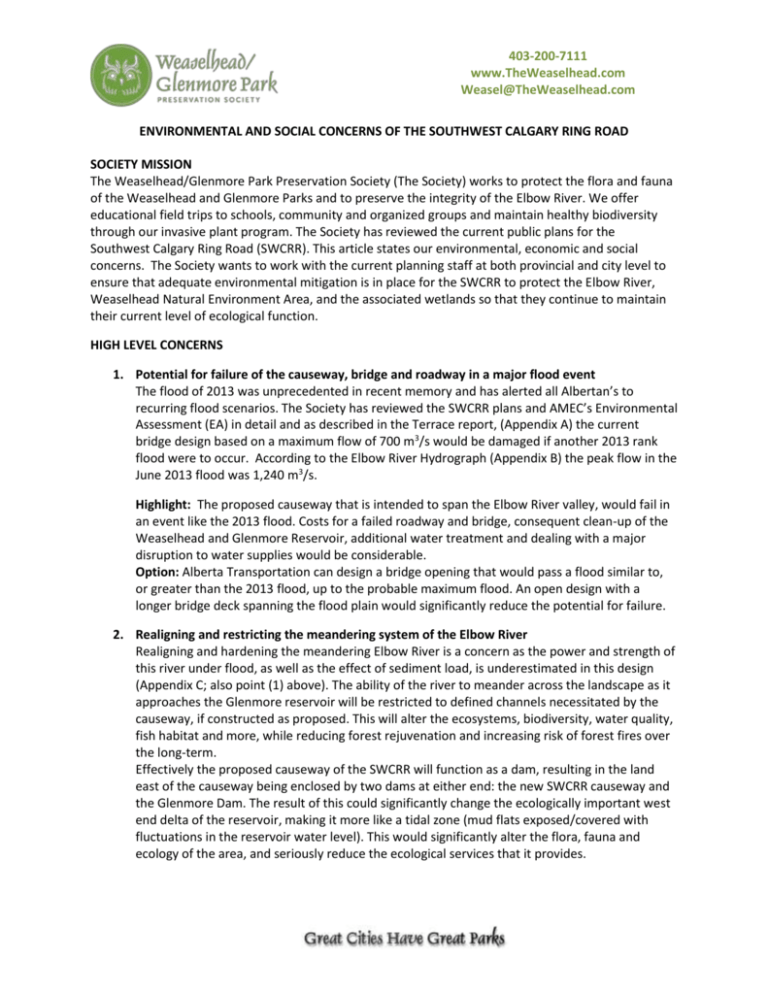
403-200-7111 www.TheWeaselhead.com Weasel@TheWeaselhead.com ENVIRONMENTAL AND SOCIAL CONCERNS OF THE SOUTHWEST CALGARY RING ROAD SOCIETY MISSION The Weaselhead/Glenmore Park Preservation Society (The Society) works to protect the flora and fauna of the Weaselhead and Glenmore Parks and to preserve the integrity of the Elbow River. We offer educational field trips to schools, community and organized groups and maintain healthy biodiversity through our invasive plant program. The Society has reviewed the current public plans for the Southwest Calgary Ring Road (SWCRR). This article states our environmental, economic and social concerns. The Society wants to work with the current planning staff at both provincial and city level to ensure that adequate environmental mitigation is in place for the SWCRR to protect the Elbow River, Weaselhead Natural Environment Area, and the associated wetlands so that they continue to maintain their current level of ecological function. HIGH LEVEL CONCERNS 1. Potential for failure of the causeway, bridge and roadway in a major flood event The flood of 2013 was unprecedented in recent memory and has alerted all Albertan’s to recurring flood scenarios. The Society has reviewed the SWCRR plans and AMEC’s Environmental Assessment (EA) in detail and as described in the Terrace report, (Appendix A) the current bridge design based on a maximum flow of 700 m3/s would be damaged if another 2013 rank flood were to occur. According to the Elbow River Hydrograph (Appendix B) the peak flow in the June 2013 flood was 1,240 m3/s. Highlight: The proposed causeway that is intended to span the Elbow River valley, would fail in an event like the 2013 flood. Costs for a failed roadway and bridge, consequent clean-up of the Weaselhead and Glenmore Reservoir, additional water treatment and dealing with a major disruption to water supplies would be considerable. Option: Alberta Transportation can design a bridge opening that would pass a flood similar to, or greater than the 2013 flood, up to the probable maximum flood. An open design with a longer bridge deck spanning the flood plain would significantly reduce the potential for failure. 2. Realigning and restricting the meandering system of the Elbow River Realigning and hardening the meandering Elbow River is a concern as the power and strength of this river under flood, as well as the effect of sediment load, is underestimated in this design (Appendix C; also point (1) above). The ability of the river to meander across the landscape as it approaches the Glenmore reservoir will be restricted to defined channels necessitated by the causeway, if constructed as proposed. This will alter the ecosystems, biodiversity, water quality, fish habitat and more, while reducing forest rejuvenation and increasing risk of forest fires over the long-term. Effectively the proposed causeway of the SWCRR will function as a dam, resulting in the land east of the causeway being enclosed by two dams at either end: the new SWCRR causeway and the Glenmore Dam. The result of this could significantly change the ecologically important west end delta of the reservoir, making it more like a tidal zone (mud flats exposed/covered with fluctuations in the reservoir water level). This would significantly alter the flora, fauna and ecology of the area, and seriously reduce the ecological services that it provides. 403-200-7111 www.TheWeaselhead.com Weasel@TheWeaselhead.com Highlight: The dynamics of the meandering Elbow River, its alluvial aquifer and the entire ecosystem need to be better understood by the engineers developing the Elbow River crossing. The long-term effects of the causeway’s design outside the right of way need to be considered. Option: Alberta Transportation should assess options where the river is given the space to move and shape the environment freely. An open concept design that spans the Elbow River valley would allow for this. 3. Long-term effect on Water Quality Water quality both upstream and downstream of the proposed causeway will be altered by the changes in sediment loading as a result of realigning and restricting the meandering qualities of the river. In time, the area west of the causeway will become silted in, leading to entirely new ecology. Salt management is addressed in the EA (SWCRR EA Report Vol. 2 Technical Appendices) in terms of runoff. However, this assessment does not address air-born salt. Air-born salt which is an obvious by-product of a busy road poses significant damage to vegetation, amphibians and aquatic invertebrates. The Beaver Pond located in close proximity to the road is of greatest concern. Water quantity in this wetland may also be affected as the road may impact surface and groundwater entering the wetland (Appendix C). In addition, long-term contaminants from the road entering the wetland complex and moving downstream into the reservoir are a concern to the drinking water for south Calgary. The route of the road has changed since the 2006 Environmental Assessment. The Assessment does not address the sale of the SW corner of the Weaselhead and the impact the road will now have on the beaver pond and oxbow wetlands in that area of the park. These wetlands contribute significant ecological services maintaining water quality in the Glenmore reservoir. They are connected to other wetlands in this ecological system and changes to them will lead to changes downstream (Appendix C). Highlight: Realigning and restricting the river will result in sediment loading. Air-born salt and other contaminants will impact the wetlands in the Weaselhead. Healthy wetlands help maintain water quality. Loss of their ability to perform this function plus the additional sediment loading of the river will result in reduced water quality in the Glenmore reservoir. Option: Alberta Environment can improve environmental mitigation efforts to preserve water quality. The road design can be made to minimize impacts on the sensitive wetlands that provide valuable ecological services. 4. Long-term effect on the Parks and Community Noise, light, biodiversity loss and other impacts of a major freeway running along this natural area are of concern to recreational users and students utilizing the park. Access to areas of peace and quiet are recognised as extremely important to the health of city dwellers; opportunities for a wide range of recreation such as currently offered by the Weaselhead are essential for a sustainable city; children need to be able to experience being outside in nature. The need for, and value of quiet spaces such as the Weaselhead will grow as Calgary grows. Highlight: The SWCRR will have significant impact on this highly used urban park. There is no other natural area comparable to the Weaselhead Park within the City limits and the long-term effects on the community due to the degradation of this protected area needs to be addressed. 403-200-7111 www.TheWeaselhead.com Weasel@TheWeaselhead.com Option: Technology is available to construct a road with minimal sound disturbance to the area, as well as reducing the environmental impacts. The Society urges citizens to ask the province for the best available road design to minimize the impacts on this valued area. MYTHS Some of the public view the SWCRR as a solution to commuter problems. In fact, the City and Province recognize that this road, due to its inner city alignment, will contribute significantly to traffic congestion on Crowchild and Glenmore Trails. The current capacity of those two highly used roads will not be able to accommodate the increased traffic generated by the SWCRR. The City estimates a minimum cost to City taxpayers of $2 billion to upgrade these City-owned roads to help alleviate increased traffic congestion. Some of the public, mainly those who have never visited the Weaselhead, are under the impression that the area is man-made. The Glenmore reservoir is man-made, and the delta wetland on the west side of the reservoir formed naturally as result of this dam. The Weaselhead Natural Environment Area lying west of the delta is not man-made but formed by the environment and the meandering Elbow River system. The traces of these movements are clearly visible in satellite images such as on Google Earth. Visitors can see 120-160 year old trees in the Weaselhead – trees that were here long before the reservoir. This is a natural area valued by thousands of park users. PUBLIC CONSIDERATIONS By choosing a cheaper road, causeway and bridge design, the Province is downloading risk and future costs onto the City. Tax payers should consider the cumulative costs associated with the current design: the potential cost of a failed road and bridge (Appendix A), decreased ecological services, increased water treatment, increased traffic to Glenmore and Crowchild Trail (that will require costly upgrades in the near future); and the long term threat to ecological integrity of the Weaselhead Natural Area. Nature Deficient Disorder is a serious social issue as humans, especially children, are spending less time outdoors resulting in a wide range of behavioural issues. Not all Calgarians have the luxury of leaving the City and enjoying nature. The Weaselhead Park is easily accessible to all and is the quietest and most bio-diverse park in the City of Calgary. The abundance of plants and animals and the opportunity to experience these diverse ecosystems in an outdoor classroom setting, or as a recreational user is important to the mental health and well-being of Calgarians. Contacts: Paul Finkleman President, Weaselhead/Glenmore Park Preservation Society 403-252-8967 president@theweaselhead.com Lisa Dahlseide Executive Director, Weaselhead/Glenmore Park Preservation Society 403-200-7111 weasel@theweaselhead.com 403-200-7111 www.TheWeaselhead.com Weasel@TheWeaselhead.com Appendix A Terrace Engineering Ltd. 2006 Southwest Calgary Ring Road Excerpt According to the document “Elbow River Bridge Crossing on the Southwest Calgary Ring Road (SWCRR) Bridge Planning Conceptual Design Report” Prepared by Terrace Engineering Ltd. 2006 (Found in Volume 2 of the Environmental Assessment). Page 4, paragraph 4 states in regard to Probable Maximum Flood (PMF): ``For the SWCRR the bridge and highway can be closed to traffic during a PMF type event thus eliminating any loss of life risk. The only issue here is whether the damages that would occur at the bridge during the PMF conditions would create increased risk to the reservoir and the dam located downstream from the bridge. The road is being designed so that the roadway will be overtopped prior to PMF flood conditions. Prior to reaching the low elevation of the roadway, there may be some minor ponding of flows with a chance that a small surge wave would be created as the roadway and bridges fail due to overtopping. However there is very limited potential storage upstream of the bridge which will limit the amount of water that can form a surge in the event of failure. Also, if this surge wave were to occur, it would likely be absorbed by the reservoir prior to reaching the dam and any surge formed as the roadway fails would have a discharge and water level lower than the design PMF at the dam. Thus, the bridges and roadway do not appear to create an increased risk to the reservoir and dam and the PMF design criteria would not apply. In conclusion, it is recommended that the design discharge of 700m 3/s representing the 1932 flood be used as the design discharge for establishing the bridge opening and bank protection system.” Appendix B Glenmore Reservoir Hydrograph Peak Reservoir inflow ~1240m3/s Appendix C Updated Version of the ROW Appendix C Road and River Alignment www.slideshare.net /YourAlberta/v6co mmunity-floodmitigation-powerpoint-publicationcopy 403-200-7111 www.TheWeaselhead.com Weasel@TheWeaselhead.com Fig. 1: Weaselhead Natural Environment Park (blue line) showing north and south escarpments and floodplain (white line); red line shows new river edge after June 2013 floods; orange line shows ‘hardening’ of this bank planned as part of Ring Road; area inside pink dotted line is NOT included in ROW (see fig. 2); broad yellow line shows planned river re-alignment; narrow yellow line shows edge of Ring Road ROW (land to east of line will be sold to the Province for the road.) February 2014 403-200-7111 www.TheWeaselhead.com Weasel@TheWeaselhead.com SEND LETTERS TO: Mr. Rob Penny Deputy Minister of Transportation 2nd Floor, Twin Atria Building 4999 - 98 Avenue Edmonton, AB T6B 2X3 Phone: (780) 427-6912 Fax: (780) 422-6515 Honourable Wayne Drysdale Minister of Transportation Government Members Legislative Branch 324 Legislature Building 10800 - 97 Avenue Edmonton, AB T5K 2B6 Phone: (780) 427-2080 Fax: (780) 422-2722 Honourable Robin Campbell Minister of Environment and Sustainable Resource Development Legislature Office 323 Legislature Building 10800 97 Avenue Edmonton, AB T5K 2B6 Phone: (780) 427-2391 Fax: (780) 422-6259 Honourable Ric McIver Minister of Infrastructure 425 Legislature Building 10800 - 97 Avenue Edmonton, AB T5K 2B6 Phone: (780) 427-5041 Fax: (780) 422-2002 Honourable Dave Hancock Premier Office of the Premier Executive Branch 307 Legislature Building 10800 - 97 Avenue Edmonton, AB T5K 2B6 Phone: (780) 427-2251 Fax: (780) 427-1349 CC your letters to: MLA Linda Johnson Constituency Offices Legislative Branch A208, 1600 - 90 Ave SW Calgary, AB T2V 5A8 Phone: 403 216-5421 Fax: 403 216-5423 Mayor Nenshi Office of the Mayor The City of Calgary P.O. Box 2100, Station M Calgary, AB, T2P 2M5 Phone: 403-268-5622 Fax: 403-268-8130 Councillor Brian Pincott P.O. Box 2100, Station M Calgary, AB, Canada T2P 2M5 Phone: 403-268-2430 Fax: 403-268-8091 Prime Minister Stephen Harper Office of the Prime Minister 80 Wellington Street Ottawa, ON K1A 0A2 Fax: (613) 941-6900 Honourable Leona Aglukkaq Minister of the Environment Les Terrasses de la Chaudière 10 Wellington Street, 28th Floor Gatineau, Quebec K1A 0H3 Phone: (819) 997-1441 Fax: (819) 953-0279 Chief Roy Whitney Tsuu T’ina 9911 Chula Boulevard Calgary, Alberta, T2W 6H6 Councillor Darrell Crowchild Tsuu T’ina 9911 Chula Boulevard Calgary, Alberta, T2W 6H6 Letters are more powerful than emails. Please feel free to use this word document to help build your letters content. Find the Environmental and Social Concerns of the SWCRR document at www.TheWeaselhead.com 6
